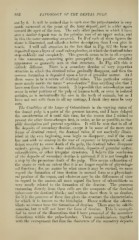Page 872 - My FlipBook
P. 872
882 PATHOLOGY OF THE DENTAL PULP.
out by b. It will be noticed that in each case the pulp-chamber is very
much narrowed at the point of the bony deposit, and is wider again
toward the apex of the root. The only other position in which I have
seen a similar deposit was in the palatine root of an upper molar, and
in this the same narrowing occurred. In B of each of these figures the
tissue is illustrated, and affords a better description than I can give in
words. I will call attention to the fact that in Fig. 477 the bone is
deposited upon a layer of small calcospherites, at which the dentinal tubes
stop suddenly and completely. This growth seems to be in all respects
a true cementum, presenting quite perceptibly the peculiar stratified
appearance so generally seen in that structure. In Fig. 478 this is
entirely different. There is a secondary dentine of very imperfect
structure in which the dentinal tubes gradually disappear, and then the
osseous formation is deposited upon a layer of granular matter. At k
there seems to be a return of dentinal tubes. This particular section
more nearly merits the name " osteo-dentine " than anything else that I
have seen from the human mouth. It is possible that osteo-dentine may
occur in other portions of the pulp of human teeth, or even in isolated
nodules, as is undoubtedly the case in the teeth of animals, but as I
have not met with them in all my cuttings, I think they must be very
rare.
The Condition of the Layer of Odontoblasts in the varying states of
the dental pulp is a point of the greatest interest, and I have delayed
the consideration of it until this time, for the reason that I wished to
present the other tissue-changes first, in order, as far as possible, to sim-
plify description and prevent repetition. It will be seen that in all of
the deposits of secondary dentine, except it be some of the more rare
forms of dentinal tumor, the dentinal tubes, if not markedly dimin-
ished at the very beginning, soon begin to disappear ; and if the case
has met with no mishap in the way of exposure or hyperaemia of suf-
ficient severity to cause death of the pulp, the dentinal tubes disappear
entirely, giving place to clear calcification, deposits of graiuilar matter,
calcospherites, or other irregular structures. I believe this conclusion
of the deposits of secondary dentine is universal if it is not brought to
a stop by the premature death of the pulp. This means exhaustion of
the organ to such an extent that it is no longer capable of physiologi-
cal function ; for, no matter by what cause it may be excited, we must
regard the formation of true dentine in normal form as a physiologi-
cal product of the organ, and whatever may be the differences of view
in regard to the matter, all must regard the layer of odontoblasts as
very nearly related to the formation of the dentine. The processes
emanating directly from these cells are the occujmnts of the dentinal
tubes—are the dentinal fibrils ; and without these there is no dentine,
for it is the presence of these that gives the structure the characteristics
by which it is known to the histologist. Hence without the odonto-
blasts we cannot have the formation of dentine. There may be calcific
material, but it will not have the form of dentine. This is exempli-
fied in most of the illustrations that I have presented of the secondary
formations within the pulp-chamber. These considerations, together
with the ever-present fact that the characters of the secondary deposits


